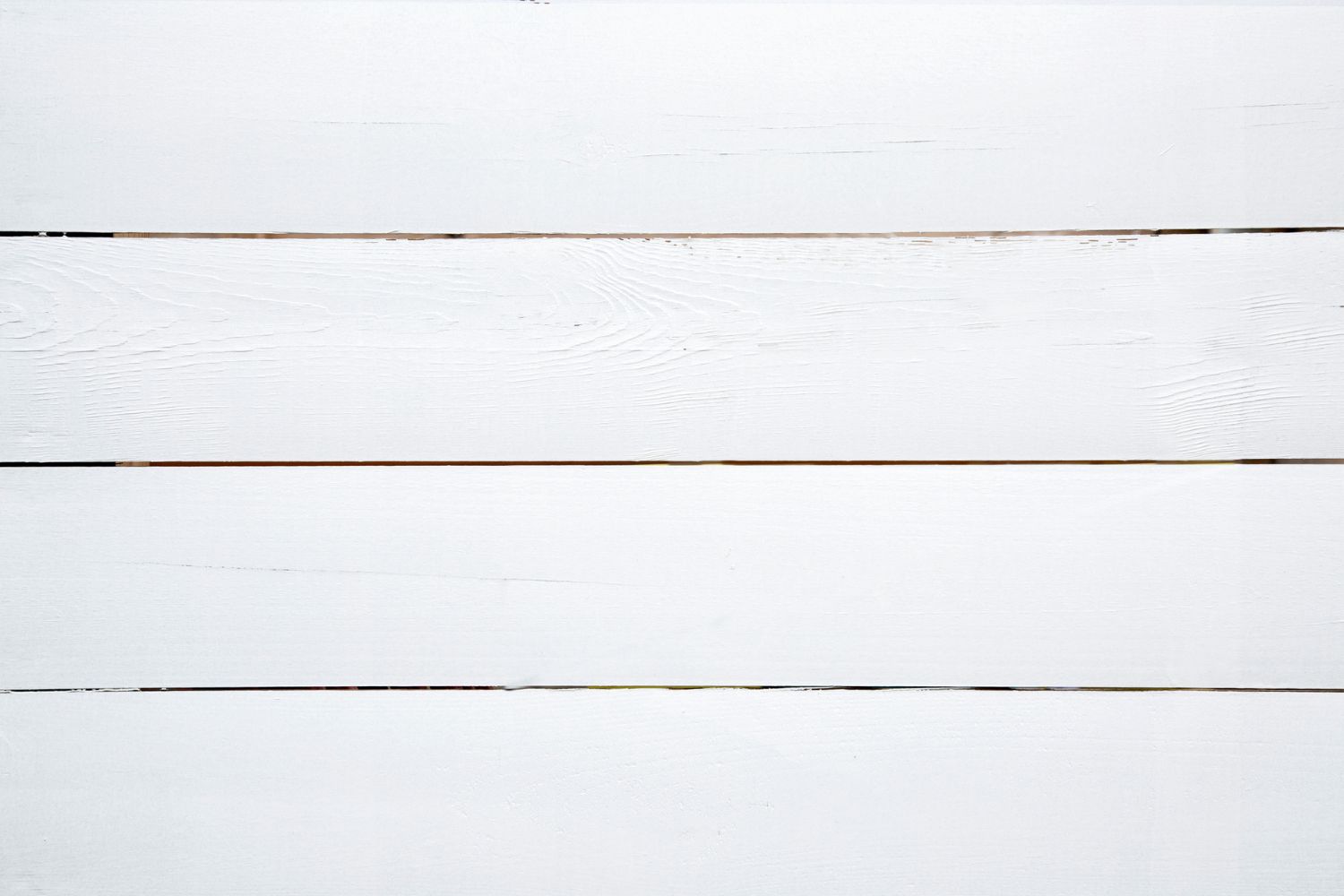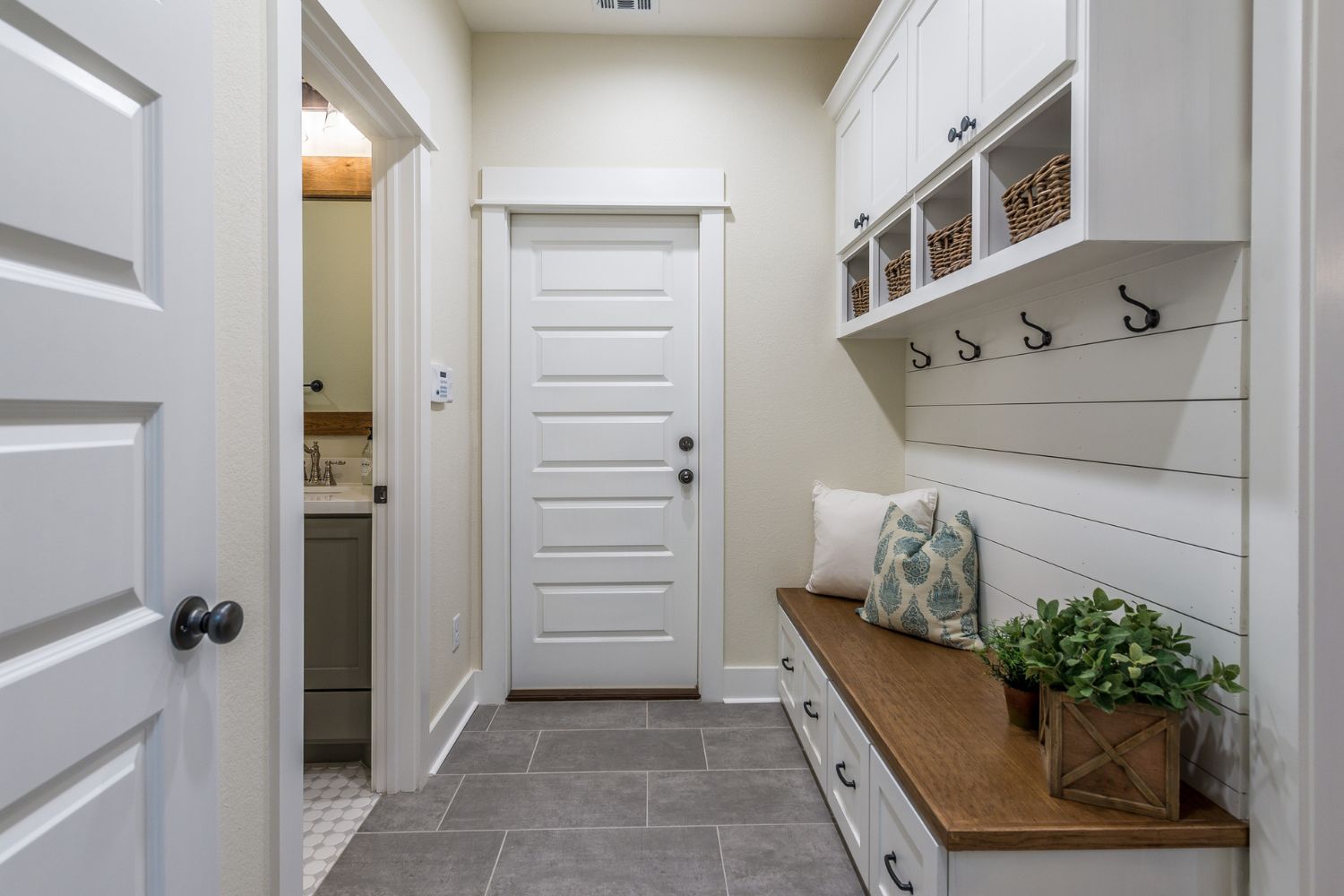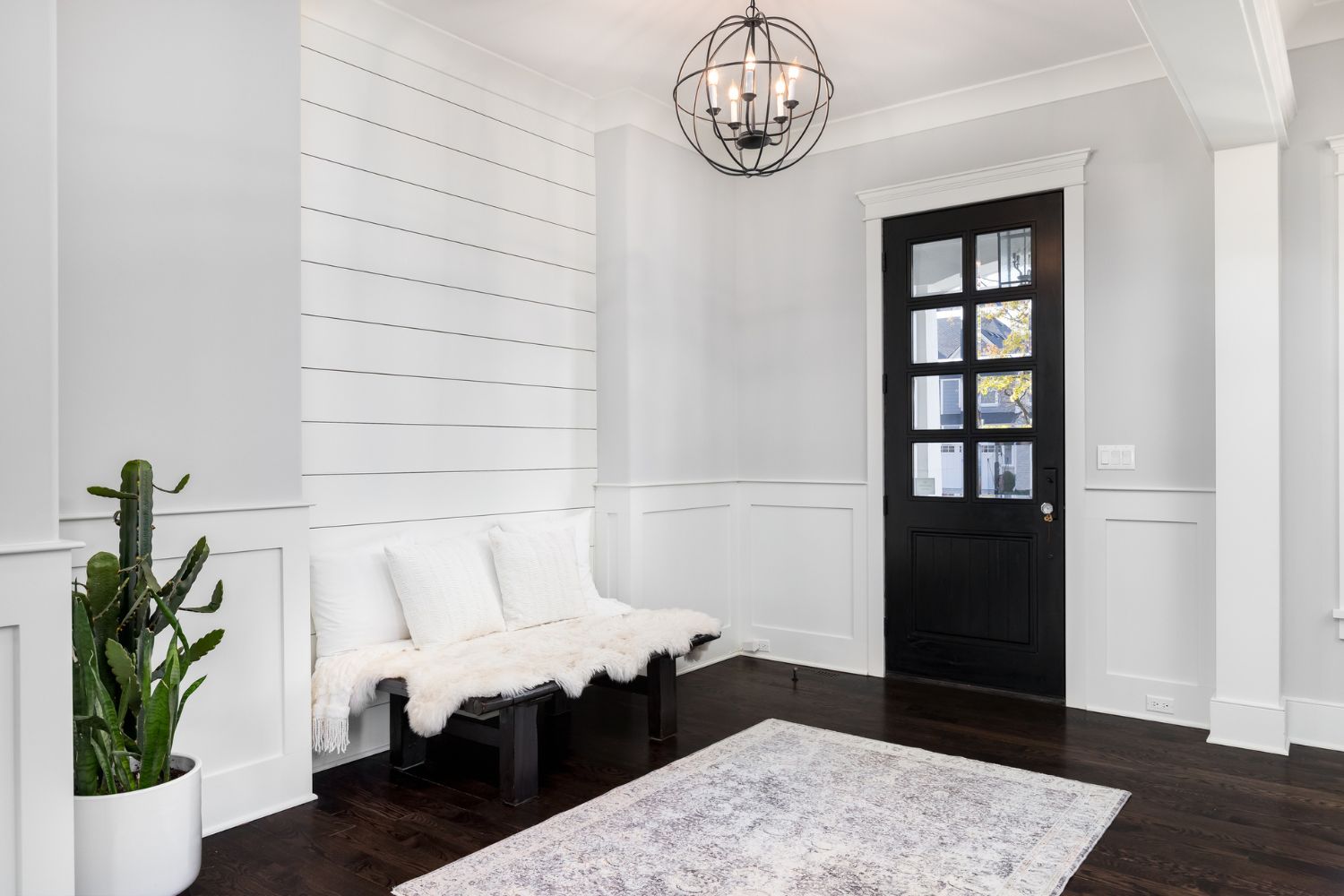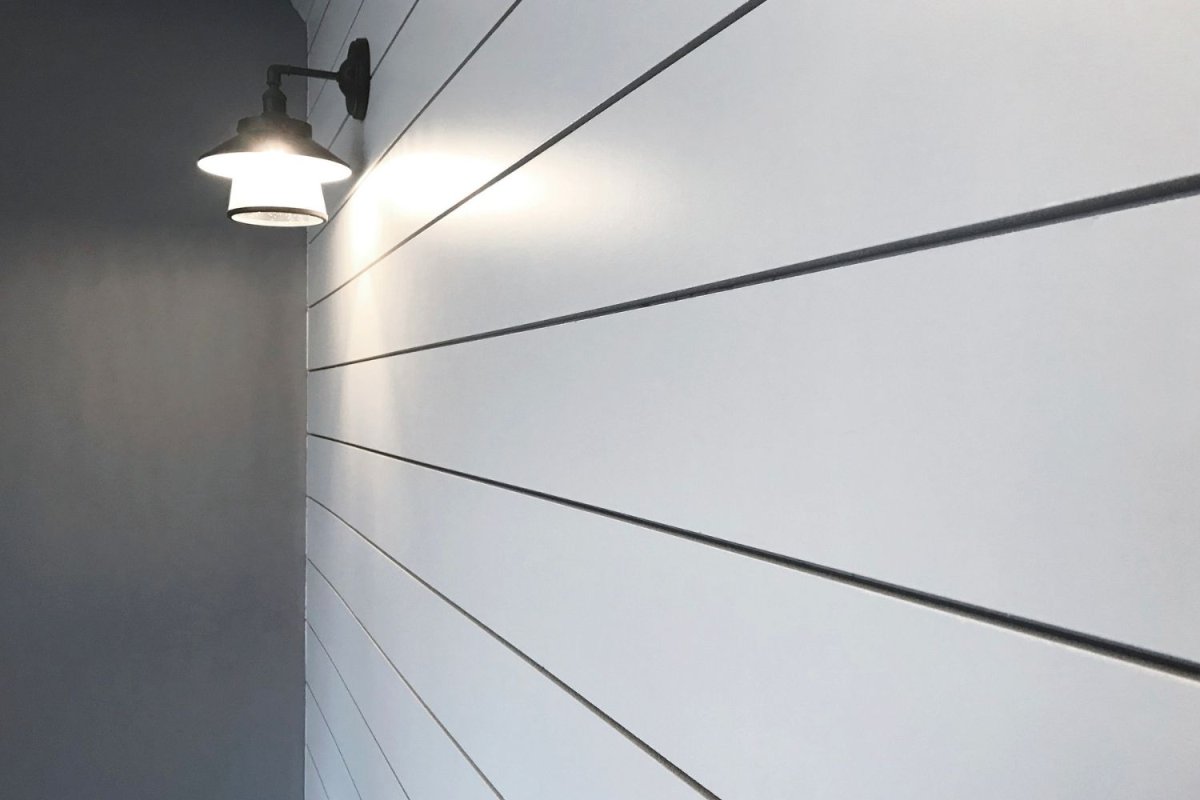We may earn revenue from the products available on this page and participate in affiliate programs. Learn More ›
Highlights
- The average shiplap cost for a 200-square-foot room is $1,000, though a typical range is $500 to $1,700. Exterior shiplap can cost as much as $7,500.
- Many factors affect the cost of shiplap, including the room size and type, board size and type, installation location, labor rates, wall repairs, and more.
- Homeowners have several benefits when choosing shiplap since it’s often cheaper than other wall materials in addition to being beautiful, durable, and easy to install.
- Half bathrooms or other small spaces might be easy areas for an experienced DIYer to install shiplap, but the precision and time required to install a full wall or exterior siding make this a job for professional contractors.
When a homeowner’s design goal is a cozy, rustic feel, then shiplap may be a perfect addition to the project. Shiplap is made up of long, wooden planks that are installed horizontally or vertically on walls, ceilings, or exterior walls. Originally, shiplap was used to build ships—hence the name. Later, home builders discovered that using shiplap for exterior siding created an extra layer of protection from the weather. Eventually, builders used shiplap on interior walls as a base for wallpaper, drywall, or plaster. That’s why renovation projects on some older homes will reveal the original shiplap, which can be restored to a fresh wall, adding character and charm to a home.
Traditionally, shiplap is white, but it can be painted any color to match a home’s decor. Shiplap costs between $500 and $1,700 to install in a 200-square-foot room, with a national average cost of $1,000, according to Angi. Exterior shiplap siding can cost between $2,800 and $7,500, according to HomeAdvisor. These costs can vary depending on the location of the shiplap installation, type of wood used, size of the boards, and amount of wood needed.

Factors in Calculating Shiplap Cost
Shiplap is a beautiful addition to nearly any style of room, but it works particularly well with rustic or cottage-style designs. It can make a statement or add character on just one wall, or it can cover the walls and ceilings of an entire room. The size of the room and boards will influence the final project price, as will labor rates, wood type, and other factors.
Room Size and Type
Installing shiplap in a small room or as an accent wall can be an inexpensive way to add character to a room. Adding shiplap to multiple walls and rooms, however, is a significant investment into a home’s design. Shiplap boards cost between $2.50 and $7 per square foot, so the size of the room has a big impact on the cost. Installing shiplap siding can cost between $2,800 and $7,500 for 1,000 square feet of walls.
To calculate the square footage of the area the shiplap will cover, homeowners can measure the length and the height and multiply the two numbers together. For example, one bedroom wall that measures 10 feet wide and 8 feet tall will have 80 square feet of wall space for installing shiplap. If the cost is $2.50 per square foot, homeowners will pay $200.
In a large game room, one wall might measure 20 feet by 9 feet, which calculates to 180 square feet. If the cost is $5 per square foot, then homeowners will pay $900. They can then decide whether the budget allows for adding shiplap to an accent wall or the entire room based on the estimated cost.
Wood Type and Board Size
“The cost of a shiplap project can vary depending on the type of wood used,” explains Danielle Nash, a San Francisco-based project director and interior designer for Freemodel. For example, hardwoods like oak or cedar will be more expensive than softwoods such as pine. The finish of the wood and overall quality will also impact cost as well as lead time when sourcing
Standard shiplap wood boards have a width of 5¼ inches or 7¼ inches, though the width, length, and thickness can vary. While the average price per board ranges from $2.50 to $7, some types of woods that are cut extra thick may cost between $9 and $15 per board. If homeowners choose smaller boards made from cheaper woods, the cost per board will be lower, though the amount needed will be higher. Wider, longer boards may cost more individually, but homeowners will need fewer. Getting estimates for different board sizes can help homeowners make the best decision that fits within their budget.
The wood type can also affect the cost to install shiplap. For example, hardwood and pine cost less than cedar and redwood. The choice of wood depends on the budget as well as the design preference since woods come with different levels of hardness and color tones.
Installation Location
Thecost to install shiplap is also dependent on where the shiplap boarding is installed. Shiplap on interior walls will cost less than shiplap siding on the entire exterior of the home. Also, shiplap installation on a ceiling will likely cost more than installation on a wall since it’s difficult to work on a ceiling and there’s more risk of personal injury.
Labor
While it’s possible for homeowners to learn how to install shiplap themselves, the process can be time-consuming. Installing shiplap also requires the right tools and a working knowledge of measuring and cutting. Professional carpenters can handle shiplap installation relatively quickly and typically charge between $35 and $100 per hour for shiplap interior walls. For exterior shiplap siding, the going rate is about $1 to $4 per square foot.
Additional Costs and Considerations
When homeowners decide to install shiplap, they may discover a few other factors that affect the cost. For example, any damaged walls will require repair before shiplap installation. And homeowners have a choice between prefinished or plain boards, which both come at their own price point.
Wall Repairs
Interior shiplap boards can cover up minor issues or blemishes on the existing wall, but if the wall is severely damaged, repairs may be necessary first. Drywall repairs cost an average of $573. Other issues such as stress cracks, bowing, and sagging can cost more to repair, especially if the damage is the result of larger, structural issues or poor initial installation.
Prefinished vs. Plain Boards
Homeowners can save on installation with prefinished shiplap boards, which are prepared ahead of time with primer and paint to match the home’s color scheme. Since they’re prefinished, these shiplap boards cost more than bare boards. To save on costs, homeowners can opt for prefinished boards that are only primed or plain boards.
Additional Materials
Additional construction materials needed for installing and finishing shiplap paneling can add to the total shiplap installation cost. The actual cost of these materials will vary depending on the geographic location and may even vary from store to store. Most projects require similar materials, such as paint, nails, and the best wood fillers, but homeowners can opt for other items, such as lighting or crown molding.
| Materials for Installing Shiplap in a 12-foot by 14-foot Room | Average Cost (Materials Only) |
| Cladding (for exterior shiplap) | $2 to $5 per square foot |
| Finish | $22 to $26 |
| Nails | $2 to $6 (two 5-pound boxes) |
| Paint | $20 to $100 per gallon |
| Primer | $100 to $125 (4 to 5 gallons) |
| Spackle | $10 to $20 (1 to 2 buckets) |
| Underlayment | $75 to $90 |
| Wood filler | $15 to $20 |
Shiplap Cost by Type of Wood
Shiplap is a beautiful drywall alternative, and there are a number of material options that allow homeowners to customize the look of their shiplap wall. Each type of wood offers its own benefits. Some are more durable, longer-lasting, or costly, while others are more affordable but may not be as durable or traditional.
Shiplap boards come with rabbeted edges that connect and create the desired spacing between each board. The difference between shiplap and tongue-and-groove boards is that shiplap has an L-shaped rabbet joint that connects to the next board for a snug fit, with a groove down the middle of each board for that traditional gap. On the other hand, tongue-and-groove boards utilize a protruding notch along one side of the board to connect into a corresponding gap in another board.
Medium-density fiberboard (MDF) and plywood boards are additional options, though they’ll need to be cut into planks. While they won’t have the rabbets, manufactured boards can be installed with a small gap between them to create an authentic look. This requires extra precision to ensure an even look.
| Type of Wood | Average Cost (Materials Only) |
| Cedar | $2.50 to $7 per square foot |
| Hardwood | $0.80 to $4 per square foot |
| Medium-density fiberboard (MDF) | $15 to $60 per sheet |
| Pine | $2.50 to $4 per square foot |
| Plywood | $30 per sheet |
Cedar
One of the more durable and popular woods to use is cedar, though it comes at a higher price per square foot (between $2.50 and $7) than simple pinewood. Cedar shiplap resists moisture, which helps prevent warping and decaying for a longer period of time, making it a good choice for exterior shiplap siding. Its natural oils also make it resistant to pest infestations.
Hardwood
Shiplap made from a hardwood could come from any variety of broadleaf trees, such as cherry, maple, or oak. Hardwood is a common material for shiplap and can be installed on the interior or exterior of the home. It typically costs between $0.80 and $4 per square foot.
Medium-Density Fiberboard (MDF)
Denser than plywood, medium-density fiberboard (MDF), is manufactured by combining wood fibers with resin and using high temperatures and pressure to form it into durable boards. Some are designed to be lightweight, while others are moisture resistant. MDF boards can be cut into shiplap boards and installed on walls and ceilings. A standard 4-foot by 8-foot sheet of MDF costs between $15 and $60 and can be cut into seven or eight average-size shiplap planks.
Pine
Shiplap made from pine works well for both interior and exterior applications. Its natural colors and textures look beautiful when stained or simply sealed, but pine can also be painted to match the aesthetic of the home. “This is my go-to for shiplap projects most of the time,” says Nash. Pine boards cost between $2.50 and $4 per square foot.
Plywood
Plywood is manufactured from multiple layers of wood veneer glued together to form a large sheet. These sheets can be cut into planks, installed, and finished to create shiplap. Plywood sheets are usually 4 feet by 8 feet and can be cut into seven or eight pieces of shiplap. A sheet of plywood typically costs about $30.

Benefits of Choosing Shiplap
In addition to its long history as a trusted building material, shiplap offers other benefits for homeowners, such as easy installation, long-lasting lifespan, affordability, and a beautiful aesthetic. These benefits and the lower price point make shiplap costs appealing to many homeowners looking to add a unique element to their home.
Easy Installation
Shiplap is easy to install since it comes with connecting grooves (called rabbets) that create the spacing in between the boards. Installing shiplap made from plywood or MDF is a little more challenging because the larger sheets need to be cut into planks, which requires a table saw or circular saw. Once the planks are cut to size, installation is more precise since the boards won’t have the grooves, which means the installer will need to ensure exact measurements to keep the boards spaced evenly.
Regular planks can be nailed to the wall with a nail gun, and then holes can be filled with wood filler. For a more rustic look, the boards can be nailed to the wall by hand, leaving the nailheads visible.
Durability
Wood is one of the oldest and most durable building materials, not to mention the most natural material. Cedar is naturally resistant to pests and rot, but hardwood and pine shiplap are also durable and long-lasting. Wooden boards can be sanded and refinished if they are damaged or starting to show wear and tear. And damaged boards can even be replaced and finished to match the rest of the shiplap as needed.
Affordability
While it’s not the cheapest wall covering, shiplap is a lower-cost option for homeowners who want a unique look. The cost to install shiplap in a 10-foot by 12-foot room falls between $240 and $840, so smaller rooms, like a bedroom or bathroom, can get a character upgrade for a relatively low price. Larger rooms like living rooms can cost between $800 and $2,800 to have shiplap installed on all four walls. However, it’s also an option to simply install shiplap on one or two walls to decrease the cost while still adding charm and character to the home.
Aesthetics
Shiplap has experienced a resurgence in popularity in recent years, with a number of shiplap wall ideas for many design preferences. Aesthetically, it works well with modern farmhouse and rustic designs, but it’s also appealing in cozy cottages, Scandinavian designs, and some modern and contemporary designs. “From a design standpoint, shiplap provides a visual interest by creating texture throughout,” says Nash.

Shiplap Installation: DIY vs. Hiring a Professional
Homeowners can learn how to install shiplap on their own relatively easily, especially if they have the right tools and experience with other woodworking projects. Installing shiplap requires a nail gun, nails, a level, a stud finder, a circular saw, a ladder, and some nickels to use as spacers. The trickiest part is getting the boards evenly lined up and holding them in place while securing them. It’s typically more time-consuming than homeowners expect to install shiplap on walls, which is why they often leave it to a pro.
Professional siding contractors are also the best bet for a homeowner who is looking for exterior shiplap installation. Any improper gaps or damaged boards can risk future water damage to the house and cause more costly repairs down the road. Pro installers also know how to ensure that the weight of shiplap doesn’t improperly affect a load-bearing wall.
Additionally, if homeowners are deciding among different wall covering options, such as tongue-and-groove, drywall, board and batten, or a standard painted wall, a professional can help them make the right decision.
How to Save Money on Shiplap Cost
As with most other projects, shiplap costs can add up quickly, but there are ways to save some money on shiplap installation costs to keep to a tighter budget.
- Opt for cheaper material. Homeowners can choose a less expensive variety of wood, such as pine or hardwood, to keep overall material costs down.
- Choose a lower-grade quality. Some woods have more knots or holes but can still achieve the right look for homeowners who don’t mind a more rustic vibe.
- DIY prep work. Homeowners can save on labor costs by preparing the area before the contractor arrives. This could include removing landscaping or removing drywall.
- Choose plain over prefinished. It’s cheaper for homeowners to install unfinished boards than prefinished boards.
- DIY painting. If plain boards are installed, homeowners can reduce labor costs by opting to prime and paint the boards on their own.
- Obtain multiple quotes. It’s always a good idea for homeowners to speak with multiple contractors and price shiplap boards from multiple stores to get the best price and value.
Questions to Ask About Shiplap Installation
If homeowners hire a professional to install shiplap in their home, they’ll want to ask questions about the installation process and overall costs before hiring. Gathering as much information ahead of time can help homeowners feel more comfortable about who they’ve hired and the quality of the project.
- Do you provide a written quote for the work?
- How many years of experience do you have?
- Do you have the proper licenses and insurance?
- Have you installed exterior shiplap before?
- How long do you estimate the job will take?
- What do I need to do to prepare for the job (e.g., move furniture, clear a path to the exterior walls, etc.)?
- Do you warranty your work?
- Who is my point of contact?
- Who will be doing the actual work?
- Will you need to subcontract any work?
- What does the cleanup process look like?
- How much will it save me if I paint the shiplap myself?
FAQs
Installing shiplap can be an easy way to add some charm and character to a space. Shiplap is a versatile material that can be installed on interior walls, ceilings, and exterior siding if sealed properly. Even with its rise in popularity as a wall covering in recent years, homeowners still may have a few questions about using it in their home.
Q. Is shiplap still in style?
Thanks to TV home-renovation shows that put shiplap back on the map, shiplap walls have experienced a resurgence in popularity in the last 10 years. However, the overall modern farmhouse style that facilitated this rise has recently declined in popularity. Still, shiplap remains a timeless element that works in a variety of design styles, especially when used as an accent wall. Adding a specific stain allows it to work in cool Scandinavian designs, while painting it a dark color adds a dramatic touch to a contemporary room.
Q. What is the most popular size of shiplap?
Shiplap boards are typically 1 inch thick by 6 inches wide. This size provides the ideal balance for the “nickel gap” of about ⅛ inch between the boards. It also is a good size for nearly any room since it won’t overwhelm small spaces but is suitable for larger rooms too.
Q. Does shiplap make a room look bigger?
Shiplap can be used strategically to make a room look bigger. Installing it vertically instead of horizontally can make the ceiling appear higher. In a narrow room, horizontal installation can make the room seem wider. Adding it on one or two walls instead of the entire room can add an interesting element that draws attention to certain areas, and it can also make the room appear bigger.
Sources: Angi, HomeAdvisor, UFP Edge


